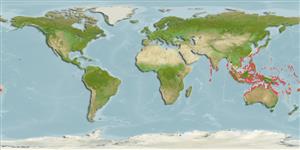>
Eupercaria/misc (Various families in series Eupercaria) >
Labridae (Wrasses) > Corinae
Etymology: Thalassoma: Greek, thalassa = the sea + Greek, soma = body; the colour of the sea (Ref. 45335).
More on author: Bleeker.
Environment: milieu / climate zone / depth range / distribution range
Sinh thái học
Biển Cùng sống ở rạn san hô; không di cư; Mức độ sâu 1 - 15 m (Ref. 1602), usually 1 - 12 m (Ref. 27115). Tropical; 24°C - 28°C (Ref. 27115); 35°N - 47°S, 70°E - 175°W
Indo-West Pacific: Maldives to Fiji, north to southern Japan, south to Lord Howe Island.
Bộ gần gũi / Khối lượng (Trọng lượng) / Age
Maturity: Lm ? range ? - ? cm
Max length : 20.0 cm TL con đực/không giới tính; (Ref. 9710)
Các tia vây lưng cứng (tổng cộng) : 8; Các vây lưng mềm (tổng cộng) : 13; Tia cứng vây hậu môn: 3; Tia mềm vây hậu môn: 11. Color pattern remains similar throughout life. Large juveniles and females are mostly black with a single white band and white area below the head to the anus. Males retain the white central band but is more yellow, and develops a second narrow band halfway towards the head (Ref. 48636). Initial phase white with 3 black bars, the first on upper half of head and anterior body containing a yellow streak at edge of opercle, the second across dorsal fin and ventrally to anus, the third covering most of body and posterior portions of dorsal and anal fins. Terminal male with yellow between black bars. Pectoral fins bluish (Ref 9823).
Occurs in groups (Ref. 90102) in exposed crests of seaward and lagoon reefs, usually rock-based. Minimum depth reported from Ref. 27115. Replaced by T. nigrofascatum in Papua New Guinea (Ref. 90102).
Life cycle and mating behavior
Maturities | Sự tái sinh sản | Spawnings | Egg(s) | Fecundities | Ấu trùng
Oviparous, distinct pairing during breeding (Ref. 205).
Randall, J.E., G.R. Allen and R.C. Steene, 1990. Fishes of the Great Barrier Reef and Coral Sea. University of Hawaii Press, Honolulu, Hawaii. 506 p. (Ref. 2334)
IUCN Red List Status (Ref. 130435)
Threat to humans
Harmless
Human uses
Các nghề cá: Tính thương mại; Bể nuôi cá: Tính thương mại
Các công cụ
Special reports
Download XML
Các nguồn internet
Estimates based on models
Preferred temperature (Ref.
123201): 23.6 - 29.3, mean 28.6 °C (based on 2503 cells).
Phylogenetic diversity index (Ref.
82804): PD
50 = 0.5000 [Uniqueness, from 0.5 = low to 2.0 = high].
Bayesian length-weight: a=0.00955 (0.00430 - 0.02123), b=3.06 (2.89 - 3.23), in cm total length, based on LWR estimates for this Genus-body shape (Ref.
93245).
Mức dinh dưỡng (Ref.
69278): 3.1 ±0.2 se; based on diet studies.
Thích nghi nhanh (Ref.
120179): Trung bình, thời gian nhân đôi của chủng quần tối thiểu là 1.4 - 4.4 năm (Preliminary K or Fecundity.).
Fishing Vulnerability (Ref.
59153): Low vulnerability (10 of 100).
Nutrients (Ref.
124155): Calcium = 77.9 [45.6, 128.6] mg/100g; Iron = 0.684 [0.398, 1.279] mg/100g; Protein = 18.4 [15.5, 20.6] %; Omega3 = 0.133 [0.085, 0.204] g/100g; Selenium = 21.7 [13.3, 38.4] μg/100g; VitaminA = 126 [39, 461] μg/100g; Zinc = 1.74 [1.23, 2.83] mg/100g (wet weight);
